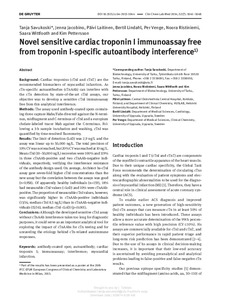Novel sensitive cardiac troponin I immunoassay free from troponin I-specific autoantibody interference
Per Venge; Jenna Jacobino; Saara Wittfooth; Päivi Laitinen; Noora Ristiniemi; Kim Pettersson; Tanja Savukoski; Bertil Lindahl
https://urn.fi/URN:NBN:fi-fe2021042714097
Tiivistelmä
BACKGROUND\nCardiac troponins (cTnI and cTnT) are the recommended biomarkers of myocardial infarction. As cTn-specific autoantibodies (cTnAAb) can interfere with the cTn detection by state-of-the-art cTnI assays, our objective was to develop a sensitive cTnI immunoassay free from this analytical interference.\nMETHODS\nThe assay used antibody-coated spots containing three capture Mabs/Fabs directed against the N-terminus, midfragment and C-terminus of cTnI and a europium chelate-labeled tracer Mab against the C-terminus. Following a 3-h sample incubation and washing, cTnI was quantified by time-resolved fluorometry.\nRESULTS\nThe limit of detection (LoD) was 2.9 ng/L and the assay was linear up to 50,000 ng/L. The total precision of 10% CV was not reached, but 20% CV was reached at 10 ng/L. Mean cTnI (10-50,000 ng/L) recoveries were 100% and 119% in three cTnAAb-positive and two cTnAAb-negative individuals, respectively, verifying the interference resistance of the antibody design used. On average, Architect hs-cTnI assay gave seven-fold higher cTnI concentrations than the new assay but the correlation between the assays was good (r=0.958). Of apparently healthy individuals (n=159), 18% had measurable cTnI values (>LoD) and 10% were cTnAAb-positive. The proportion of measurable cTnI values, however, was significantly higher in cTnAAb-positive individuals (13/16, median cTnI 8.5 ng/L) than in cTnAAb-negative individuals (15/143, median cTnI
Kokoelmat
- Rinnakkaistallenteet [19218]
